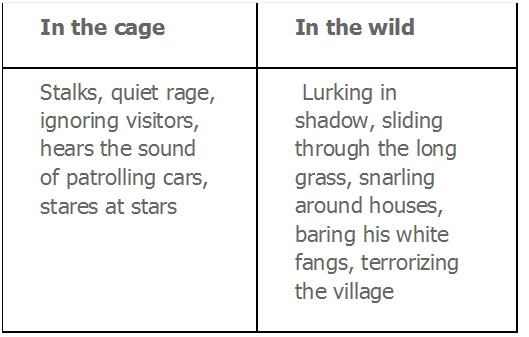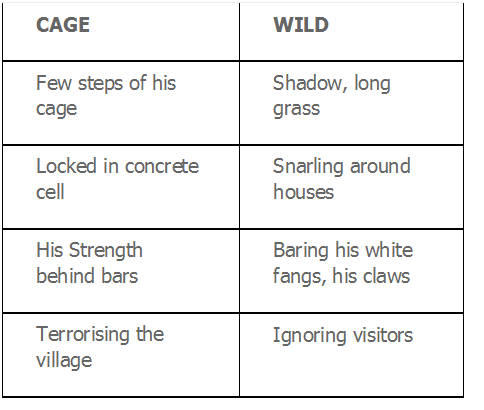- Books Name
- Online English tutor English Book
- Publication
- Online English tutor
- Course
- CBSE Class 10
- Subject
- English
Tiger in the Zoo
By George Leslie Norris
About the Poet
George Leslie Norris (1921-2006) was a Welsh poet and short story writer. His literary works have won many prizes. His famous works are Finding Gold, The loud winder, phoenix living poets series: Ransoms, etc.

Summary
‘This poem has put put forth the plight of tiger by comparing between a tiger in the zoo with the tiger in its natural habitat.
The poem highlights a contrast in the mood and environment of a tiger when he is in the zoo and a tiger when he is in the forest.
In the zoo, a tiger is tamed and thus looses his freedom and respect as a ferocious and powerful king of animals.
In a cemented cell behind the bars he feels angry, frustrated and helpless. And long for his natural habitat, his entity of being a terror for villagers.
In the zoo, he is helpless and a showpiece or source of entertainment to people.
The poet wants to convey that it is cruel to keep wild animals in small enclosures of the zoo, away from their natural habitat. They feel angry, helpless and unhappy in the cage. To overcome his sorrow and plight he stares at the brilliant stars with his bright eyes, in the silence of night.
Explanation
He stalks in his vivid stripes
The few steps of his cage,
On pads of velvet quiet,
In his quiet rage.
Word meanings
- Stalks: follows
- Vivid: bright coloured
- Pads: paws of tiger
- Rage: anger
the poet says tiger in the zoo that is confined behind the bars moves around in the cage under his bright coloured skin.
He can take only a few steps as the cage iis too small and it is not easy to move in it. His footsteps are inaudible as he has very soft feet, like velvet. Since he is not free, he is controlling his anger by quietly walking in the limited area of his cage.
Literary devices
- Rhyme scheme: abcb (cage-rage)
- Personification: The tiger is personified because the poet refers him as ‘he’.
- Metaphor: Tiger’s paws are compared with velvet (pads of velvet)
- Enjambment: Sentence is continuing to next line without any punctuation mark.
- Imagery: poet tries to create an image about the tiger (He stalks in his vivid stripes The few steps of his cage)
- Consonance: use of ‘s’ sound (stalks, his, stripes)
- Assonance: use of vowel sound ‘I’ (in his vivid stripes)
- Oxymoron: use of adjectives opposite in meaning (quiet rage)
He should be lurking in shadow,
Sliding through long grass
Near the water hole
Where plump deer pass.
- Lurking: To be hidden as to wait for your prey
The poet says that instead of being in the cage he should be prowling behind the long grasses waiting for his prey as his actual habitat is forest.
Literary devices
- Rhyme: rhyme scheme is abcb (grass-pass)
- Enjambment: Line continues to next line without punctuation marks. (Sliding through….deer pass)
- Alliteration: use of sound ‘p’ at the start of two words (plump pass)
- Imagery: The poet has tries to create an image of tiger’s activities (lurking in shadow).
He should be snarling around houses
At the jungle’s edge,
Baring his white fangs, his claws,
Terrorising the village!
Word meanings
Snarling: warning sounds made by animals
Baring: uncovered
Fangs: Sharp tooth of animals
The poet says that if the tiger would have been free, he would have been terrorizing the villagers living beside the forest, by his sharp teeth and claws.
Being free he would have been an actual ferocious tiger for humans instead of a piece of entertainment.
A Tiger in the Zoo Literary devices
- Rhyme Scheme: abcb rhyme scheme is followed (edge, village)
- Enjambment: Line continues to next line without punctuation marks (He should be snarling around houses At the jungle’s edge,)
- Onomatopoeia: using words which denote sound (snarling)
- Assonance: use of vowel sound ‘o’ and ‘I’ (should, around, houses), (Baring, his, white, his)
- Consonance: use of consonant sound ‘s’ (his, fangs, his, claws)
But he’s locked in a concrete cell,
His strength behind bars,
Stalking the length of his cage,
Ignoring visitors.
- Concrete: building made of bricks, cement, sand and water
The poet illustrates the real sad condition of the tiger that it is confined in a strong cell which is made of strong building material.
He further says that as the tiger is confined in the bars, his power and ferociousness are also confined.
He just stalks in the cage. He never tries to terrorise the visitors as he is aware about his limitations that in the cage his ferociousness is of no use, nobody is going to be terrorise. Therefore, he never tries to terrorise the visitors as he cannot attack them.
Literary devices
- Rhyme Scheme: abcb rhyme scheme is followed (bars-visitors)
- Personification: The tiger is personified because the poet refers him as ‘he’.
- Assonance: use of vowel sound ‘e’ (he, locked, concrete, cell)
- Consonance: use of consonant sound ‘s’ (his, strength, bars)
- Alliteration: use of sound ‘b’ at the start of two words (behind bars)
He hears the last voice at night,
The patrolling cars,
And stares with his brilliant eyes
At the brilliant stars.
Word meanings
Patrolling: to guard, to vigil
The poet says that in the night, the tiger hears the sounds of the patrolling cars then stares at the shining stars with his shining eyes. The poet wants to convey the fact that the tiger is sad and as he is confined in the cage, so, he cannot do anything. Therefore, he stares at the stars in the night and tries to divert his thoughts towards them.
Literary devices:
- Rhyme Scheme: abcb rhyme scheme is followed (cars-stars)
- Enjambment: Line three continues to line four without any punctuation mark. (And stares with his brilliant eyes At the brilliant stars.)
- Alliteration: use of sound ‘h’ in the starting of two words (he hears)
- Assonance: use of ‘I’ sound (with, his, brilliant)
Question Answers
Q1- Read the poem again, and work in pairs or groups to do the following tasks.
(i) Find the words that describe the movements and actions of the tiger in the cage and in the wild. Arrange them in two columns.
(ii) Find the words that describe the two places, and arrange them in two columns.
Now try to share ideas about how the poet uses words and images to contrast the two situations.
Answer-
(1)

(2)

Q2- Notice the use of a word repeated in lines such as these:
(i) On pads of velvet quiet, In his quiet rage.
(ii) And stares with his brilliant eyes At the brilliant stars.
What do you think is the effect of this repetition?
Answer- The poet has repeated the words to emphasize that the tiger has to walk in the limited area of his cage. He cannot run as he would have done had it been in the forest.
Whereas ‘quiet rage’ phrase is used to illustrate his hidden anger due of his confinement in the cage. R
The next word he used is ‘brilliant’. The word brilliant in the first line means the twinkling bright stars and the brilliant words used for the tiger’s eyes shows the sadness of the tiger who would have led a free and fearless life if it were in the jungle.

 ACERISE INDIA
ACERISE INDIA
 Online English tutor
Online English tutor
